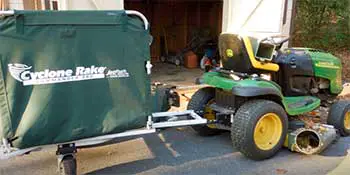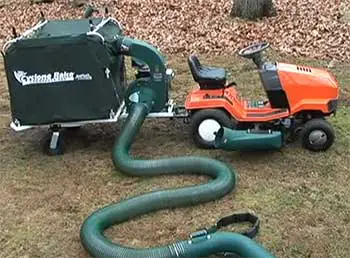When it comes to fall cleanup and getting your lawn ready for winter, having the right tools can make a huge difference in time and effort. Two popular options for leaves and debris removal are the DR Lawn Vacuum and the Cyclone Rake.
But with different features and capabilities, which one is better for your needs?
In this comprehensive guide, we’ll compare the DR Lawn Vacuum and Cyclone Rake head-to-head on key factors like power, efficiency, ease of use, and more.
Whether you have a small suburban yard or acres of land to maintain, you’ll have the information you need to decide which machine is the best fit.
We’ll also walk through the pros and cons of each model and look at real-world performance and reviews. By the end, you’ll understand exactly what sets these yard cleanup tools apart and which is right for your property.
DR Lawn Vacuum And Cyclone Rake Comparison Table
| Feature | DR Lawn Vacuum | Cyclone Rake |
| Power Source | Gas engine | Tow behind ATV/tractor |
| Collection System | Metal impeller blade and bag | Steel tines and hopper |
| Debris Capacity | 6 bushels | 10 bushels |
| Width of Cut | 22 in. | 5 ft. |
| Terrain Handling | Good on flat areas | Good on flat or sloped areas |
| Ease of Use | Self-propelled, hand steering | Must be towed behind vehicle |
| Extra Features | Shreds leaves; versatile attachments | Faster cleanup over large areas |
How The DR Lawn Vacuum Works?

The DR Lawn Vacuum is a self-contained, walk-behind debris collector powered by a commercial-grade 5.5 HP engine. As you roll it across your property, the vacuum head ingests leaves, twigs, grass clippings, and other yard waste.
Inside the housing, a metal impeller blade pulverizes the debris into small pieces and directs them up the discharge chute into a rear bag. The bag can hold up to 6 bushels of material for easy disposal.
The housing on the DR Lawn Vacuum measures 22 inches wide, making it ideal for navigating between landscaping beds and trees. Since it operates independently with its own engine, you don’t need a tow vehicle to operate it. Steering and speed are controlled with hand levers.
The vacuum can handle wet or dry debris without clogging. A special turbo nozzle on the intake helps dislodge stuck-on leaves from paved areas. Many homeowners invest in the optional hose kit to access hard-to-reach spots or clean gutters.
With the right attachments, the DR Lawn Vacuum converts into a wood chipper/shredder for driveway and garden debris. It requires unleaded gasoline and standard engine maintenance.
How The Cyclone Rake Works?

The Cyclone Rake is a tow-behind debris collector designed for large, open yards and rural acreage.
It attaches to the back of an ATV, tractor, or other vehicle with a tow hitch.
As you drive forward, the rake’s steel tines comb through grass and leaves, channeling them back into a large hopper bag. The bag’s capacity is 10 bushels, significantly more than the DR Lawn Vacuum.
The rake head on the Cyclone Rake measures 5 feet wide, over double the intake of the DR model. This allows you to cover more ground in a single pass. The tines are adjustable to different heights to handle whatever volume of debris you encounter.
Since the Cyclone Rake is towed, you can easily maneuver it over hilly or uneven terrain. The tines help break up debris, though it does not shred or chip it like the DR vacuum. Once full, you manually unload the hopper bag.
Some Cyclone Rake models allow you to attach a mower deck underneath to cut grass while also collecting clippings. Optional mesh screen bags allow excess debris to escape while maintaining larger leaves and sticks.
DR Lawn Vacuum Pros

- Powerful suction and debris grinding – The DR Lawn Vacuum doesn’t just collect yard waste, but shreds and pulverizes it for easier disposal.
- Doesn’t require a tow vehicle – As a self-propelled unit, the DR Lawn Vacuum can operate independently and maneuver in tight spaces.
- Efficient on flat terrain – With its concentrated suction power, the DR vacuum works quickly across open yards with minimal contours.
- Ability to access hard-to-reach areas – Adding a hose kit allows the vacuum to clean tight spots between landscaping or remove debris from gutters.
- Versatile attachments available – Beyond vacuuming, you can add wood chipping and shredding features for complete yard cleanup.
Cyclone Rake Pros
- Larger debris capacity – The 10 bushel hopper bag on the Cyclone Rake lets you collect more debris before needing to stop and empty.
- Covers more ground quickly – The 5-foot wide intake makes fast work of leaf and grass removal over large, open areas.
- Ability to handle slopes and uneven terrain – Towed behind a vehicle, the Cyclone Rake maneuver well over hilly or bumpy areas.
- ** Higher power from tow vehicle** – By leveraging the power of an ATV or tractor, the Cyclone Rake operates efficiently without needing its own motor.
- Grass mowing integration – Certain models allow simultaneously mowing grass while gathering the clippings.
DR Lawn Vacuum Cons
- Smaller debris capacity – With only a 6 bushel rear bag, more frequent stops are required to empty the DR Lawn Vacuum.
- Not ideal for slopes or bumps – While maneuverable, the unit lacks traction on uneven or hilly terrain compared to a towed model.
- Width limited to 22 inches – The DR vacuum can’t cover ground as quickly with its narrow intake compared to wider tow-behind models.
- Requires fuel and engine maintenance – Gasoline, oil changes, and engine upkeep are needed to operate the self-powered unit.
- No integration with mowing – There is no ability to simultaneously mow and collect clippings like some tow-behind models offer.
Cyclone Rake Cons
- No debris grinding or shredding – All debris collected by the Cyclone Rake stays intact, which can make disposal more difficult.
- Must be towed by vehicle – You need access to an ATV, tractor or truck to maneuver and operate it.
- Manual unloading required – Offloading the 10 bushel hopper bag is a manual process, unlike self-powered vacuums that eject into a bag.
- Not ideal for flat, tight spaces – The broad intake and towing configuration causes some maneuverability issues around trees and tight spots.
- No vacuum pressure – The Cyclone Rake relies on raking tines rather than suction, so some debris may be missed or left behind.
Recommendation
So which machine is better, the DR Lawn Vacuum or Cyclone Rake?
The answer depends on your specific lawn size, terrain, and cleanup needs. Here are some key factors to help choose:

- For typical small-to-medium sized residential lawns under half an acre, the DR Lawn Vacuum is likely the better choice. It has concentrated vacuum power in a compact unit that’s easy to maneuver and requires no tow vehicle.
- For large, wide open lawns or rural properties over an acre, the Cyclone Rake is likely the better choice. It can cover more ground quickly and handles slopes and uneven terrain well.
- If you value debris grinding for easier disposal, the shredding action of the DR vacuum provides an advantage. But if you simply need to corral huge quantities of yard waste, the Cyclone Rake has much greater capacity.
- For properties with tight landscaping and obstacles to work around, the high maneuverability of the DR Lawn Vacuum comes in handy. But on open fields with few barriers, the wide intake of the Cyclone Rake will be more efficient.
Assess your specific lawn maintenance needs and compare them to the strengths and limitations of both machines. And consider any slopes, obstacles, yard waste volumes or accessory needs that impact your decision.
While both are quality tools, choosing the model best aligned to your property and cleanup style will ensure the optimal experience.
Also Read: Comparison of Giraffe And Hoselink Hose Reels.
FAQ About DR Lawn Vacuum and Cyclone Rake
Yes, the Cyclone Rake is an effective tool for picking up loose grass clippings in addition to leaves and other lawn debris. The steel tines will comb through grass and channel cuttings back into the collection hopper. Some Cyclone Rake models even have a mower attachment to cut and collect grass in one pass.
If your Cyclone Rake has an integrated mower deck, then yes, you will engage the mower blades to cut grass while also collecting the clippings. If you purchase just the tow-behind rake itself with no mower attachment, then there is no need to run any blades. The tines will simply grab and direct grass and leaves into the hopper.
The Cyclone Rake can collect small twigs and sticks in addition to standard yard waste. Its steel tines will grab debris up to about a half-inch thick and channel it back into the hopper bag. However, larger branches and woody debris may be too bulky for the rake mechanism.
DR Lawn Vacuums are self-propelled, walk-behind units powered by a gas engine and metal impeller blades inside the housing. As you roll the unit forward, the impeller generates suction that pulls leaves and debris up the intake nozzle and into the collection bag. The impeller grinds and shreds yard waste for more compact storage.
Final Thoughts
Maintaining a pristine lawn and yard requires removing not just grass clippings but also fallen leaves, twigs and other debris.
When selecting a tool to handle this seasonal cleanup, the DR Lawn Vacuum and Cyclone Rake both offer powerful solutions with their own unique advantages.
The self-propelled DR Lawn Vacuum provides excellent suction and shredding capabilities from its robust vacuum motor and metal impeller blades. But the tow-behind Cyclone Rake can cover far more ground quickly with its broad intake tines, while also handling sloped and uneven terrain when pulled by an ATV or tractor.
Think about your specific property size, terrain, maneuverability needs and preferred leaf disposal method as you choose between these two high-performing debris collectors. Both the Cyclone Rake and DR Lawn Vacuum will make fall cleanup and lawn restoration much easier.
Whether you value raw power, wide coverage, hopper capacity or adaptability, one of these yard tools likely fits the bill for your leaf and grass debris pickup needs.

First of all there are two different brands of cyclone rake. One brand the one with 3 spining tine rake wheels. Is Basically a miniture hay rake used to windrow hay into rows for the hay bayler to pick and make into bales or rolls of hay. The other cyclone rake at first look is identical to the DR. brand. Both have large clipping baskets and engines mounted to shredders that suck grass clippings from mowerdeck into the shredder then blown into clipping bin. The diffrence is Dr
Uses a metal impeller ( that get dammaged by rocks and hard debris) and the cyclone rake uses a polymer impeller that allows rocks and hard debris to bounce through with damaging the impeller, but things can get stuck with this flexibility. Clclone rake uses larger diameter hoses than the Dr. Which in theroy leads to less debris cloging up the hose.
Your also compairing a Dr self-propelled (walk behind) lawn vaccume in here also.
So if your going to do a comparison dont talk about the 3 tine rake and show pictures of the cyclone rake Xl. and pictures of the Dr lawn
vaccume. Or throw in the walkbehind lawn vaccume